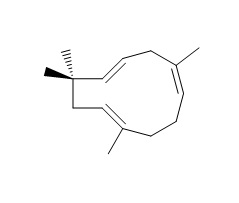Alpha-caryophyllene
Alpha-humulene and trans-caryophyllene extracted from S.officinalis essential oil can inhibit tumor cell growth; they also show marked anti-inflammatory effects, probably by interfering with TNFalpha production.
Inquire / Order:
manager@chemfaces.com
Technical Inquiries:
service@chemfaces.com
Tel:
+86-27-84237783
Fax:
+86-27-84254680
Address:
1 Building, No. 83, CheCheng Rd., Wuhan Economic and Technological Development Zone, Wuhan, Hubei 430056, PRC
Providing storage is as stated on the product vial and the vial is kept tightly sealed, the product can be stored for up to
24 months(2-8C).
Wherever possible, you should prepare and use solutions on the same day. However, if you need to make up stock solutions in advance, we recommend that you store the solution as aliquots in tightly sealed vials at -20C. Generally, these will be useable for up to two weeks. Before use, and prior to opening the vial we recommend that you allow your product to equilibrate to room temperature for at least 1 hour.
Need more advice on solubility, usage and handling? Please email to: service@chemfaces.com
The packaging of the product may have turned upside down during transportation, resulting in the natural compounds adhering to the neck or cap of the vial. take the vial out of its packaging and gently shake to let the compounds fall to the bottom of the vial. for liquid products, centrifuge at 200-500 RPM to gather the liquid at the bottom of the vial. try to avoid loss or contamination during handling.
J Sci Food Agric.2023, 103(1):213-220.
Molecules.2022, 27(7):2116.
J Med Food.2024, 27(8):728-739.
Neurochem Res.2021, s11064-021-03449-0
Korean. J. Pestic. Sci.2024, 28(3):241-248.
Plants (Basel).2023, 12(1):163.
Antioxidants.2022, 11(3):592.
J Appl Biol Chem.2024, 67:33,238-244
Phytochem Anal.2021, 32(6):970-981.
Nutrients.2019, 11(4):E936
Related and Featured Products
An. Real Acad. F., 2010, 76(3):343-56.
Cytotoxic activity of alpha-humulene and trans-caryophyllene from Salvia officinalis in animal and human tumor cells[Reference:
WebLink]
The purpose of the present work is two-fold: the fractionation of Salvia officinalis essential oil and the cytotoxic study of this oil with its fractions "in vitro" tumor cell lines.
METHODS AND RESULTS:
S. officinalis essential oil was obtained by hydrodistillation and fractionated with column chromatography; the essential oil and its fractions were analyzed by gas chromatography (GC) coupled to mass spectrometry (MS). The cytotoxic activity was evaluated in cellular lines of breast cancer MCF-7, colon cancer HCT-116, and murine macrophage RAW264.7 cell lines by the MTT assay Results: the sub-subfraction F1.1.1 of S. officinalis essential oil containing alpha-humulene present highest activity on RAW264.7 and HCT-116 with IC(50) values of 41.9 and 77.3 mu g/ml, respectively. The sub-subfraction F1.2.1 of S. officinalis essential oil with trans-caryophyllene(Alpha-caryophyllene) showed less activity on RAW246.7 and HCT-116 with IC(50) values of 90.5 and 145.8 mu g/ml.
CONCLUSIONS:
This paper suggests that the a-humulene and trans-caryophyllene extracted from S.officinalis essential oil inhibit tumor cell growth.
Medicines (Basel) . 2017 May 25;4(2):34.
Anti-Inflammatory, Antioxidant, Antibiotic, and Cytotoxic Activities of Tanacetum vulgare L. Essential Oil and Its Constituents[Pubmed:
28930249]
Abstract
Background:Tanacetum vulgare L. (Asteraceae) is a perennial herb that has been used to treat multiple ailments. Regional variability of the chemical composition of T. vulgare essential oils is well-known. Despite these regional chemotypes, most relevant studies did not analyze the complete chemical composition of the T. vulgare essential oil and its constituents in relation to their biological activities. Here, we assess the anti-inflammatory, antioxidant, antibacterial, and cytotoxic activities of T. vulgare collected from northern Quebec (Saguenay-Lac-St-Jean), Canada. Methods: Essential oil was extracted from plants by steam distillation and analyzed using GC-FID. Biological activities of essential oil and its main constituents were evaluated in vitro. Results: We identified the major compounds as camphor, borneol, and 1,8-cineole. The oil possesses anti-inflammatory activity inhibiting NO production. It also inhibits intracellular DCFH oxidation induced by tert-butylhydroperoxide. Anti-inflammatory activity of essential oil appears driven mainly by α-humulene while antioxidant activity is provided by α-pinene and caryophyllene oxide. Essential oil from T vulgare was active against both Escherichia coli and Staphylococcus aureus with camphor and caryophyllene oxide responsible for antibacterial activity. Finally, T. vulgare essential oil was slightly cytotoxic against the human healthy cell line WS1 while α-humulene and caryophyllene oxide were moderately cytotoxic against A-549, DLD-1, and WS1. Conclusion: We report, for the first time, links between the specific compounds found in T. vulgare essential oil and anti-inflammatory, antioxidant, antibacterial, and cytotoxic activities. T. vulgare essential oil possesses interesting biological properties.



